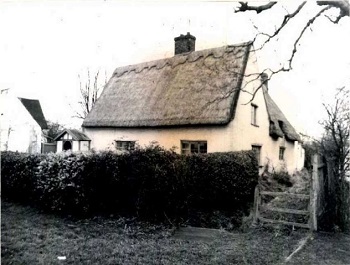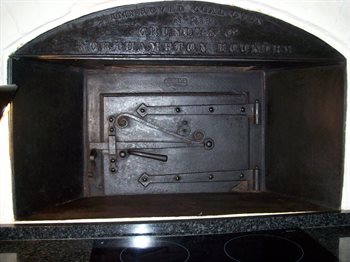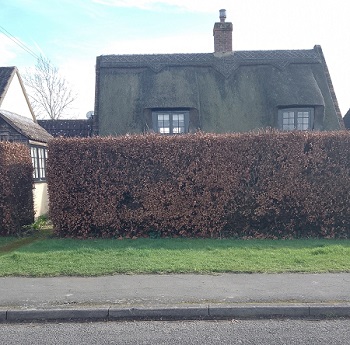Moorfield, 53 The Moor
This page was written by Pamela Hider.

Moorfield, 1970s [Courtesy of HER]
One of the earliest houses in Carlton, it is described by the Historic Environment Record for Bedfordshire as follows:
C17 house. Colourwashed coursed limestone rubble. Thatched roof with tile gable coping. 2-bay plan. Central, double red brick ridge chimney stack. One storey and attics. N.W. elevation: ground floor two 3-light casement windows with bars. C20 gabled porch to north east end. Recent windows (1986) at front.
Bakers at Moorfield
Traditionally, Moorfield was known to be a bakery and the 1854 Post Office Directory lists one James Chambers as baker. A conveyancing document¹ for Moorfield, which lists previous owners, places him there in 1866. By the time of the 1871 census, James' wife Elizabeth had died. Now a widower, he was described as a baker and wood dealer. The latter was hardly surprising as his two sons were both carpenters and lived with their respective families next door and next door-but-one to James. James' daughter, Mary, was described as housekeeper.
When James himself died (aged 69) in 1879, the next baker was his daughter Mary, who appeared in the list of owners as Mary Pearson Chambers. Mary's maternal grandmother had been Mary Pearson of Eaton Bray, who, when she died a widow in 1845, left all her estate to her daughter and son-in-law, Elizabeth and James Chambers (baker) of Carlton (ABP/W1846/1). Perhaps this enabled the business to be developed and Mary carried it on after her father's death. She was listed herself as baker and wood dealer in Kelly’s directory of 1885 and as baker in the 1891 census, with a servant. She died that same year (aged 57) having never married (despite erroneously being described as ‘Mrs’. in Kelly’s).
The next baker in the list of owners was Jabez Wooding, in 1894. He was also listed in Kelly's directory of 1898, but by 1902 was living in Turvey (Electoral Rolls) and listed as a Turvey baker in Kelly's directory of 1903. The baker's oven had been installed at Moorfield in the late 19th century and is still there in the 21st century!

"Improved Coal Oven No.218 Grundy & Co Northampton Foundry"
No evidence has been found that the premises continued as a bakery after the turn of the century. The bakery business seems to have migrated to Bridgend. The next occupier of Moorfield was Edward Skevington, described as a woodman & labourer in the 1901 census. A traditional story in the village² was told by one of his children who related how a candle left at the bottom of the stairs at night caught the curtain and started a fire. Roof timbers are said to be still charred pink by that fire.
The next owner was Arthur John Morel Edmonds, who had moved from London to Carlton. He and his wife became members of Harrold Reform Church in 1903 (Z1521/1/10/4) and he first appeared in Carlton electoral rolls in 1908. He lived in the High Street but owned several properties in Carlton and appeared as a 'private resident' in Kelly's Directory of 1914. He is thought to have owned Moorfield from the early 1900s until c.1922.
Rating and Valuation Act 1925
This Act specified that every building and piece of land in the country was to be assessed to determine its rateable value. This was done in Carlton in 1927 (DV1/C218). By now, the owner and occupier of Moorfield was Mrs.G.Thomson. The property was described as being built of stone and thatch, detached, lean-to workroom, living room, kitchen, scullery, stairs, 3 bedrooms. Barn + Brick & Thatch garage. Another hand has written 'Neat week-end country cottage type. Attractive'.
Extensions were made to the property in the 1970s.
 Moorfield 2024
Moorfield 2024
¹ in private hands
² unpublished memoir of Carlton & Chellington Historical Society